AI in Energy: Overcoming Unforeseen Obstacles
Abstract
1. Introduction
- 1950: Early experimentation with AI in energy engineering.
- 1960: Development of expert systems for energy management.
- 1970: AI applications in power system control and optimization.
- 1980: Introduction of fuzzy logic and neural networks in energy systems.
- 1990: Integration of AI in renewable energy systems.
- 2000: Smart grid and demand response with AI integration.
- 2010: Advancements in predictive maintenance with machine learning.
- 2011: IBM’s Watson aids energy management for buildings.
- 2014: Google’s DeepMind applies AI for energy efficiency in data centers.
- 2018: AI-powered energy storage management systems.
- 2021: AI used for real-time monitoring and control of energy systems.
- 2022: AI-driven energy trading platforms and market analysis.
- Diverse values and acceptance among people.
- Measuring environmental and social value creation.
- Involving customers and enterprises across the value chain.
- Research spans multiple disciplines and complex systems.
- Innovation policy focused on ecosystems, agility, and outcomes.
- Need for productivity and substantial investments.
2. Unseen Challenges of AI in Energy
3. AI Integration Requirement and Conundrum
4. Data-Driven Modeling
5. Robotic Process Automation (RPA)
6. AI-Integrated Energy Policy Development
- Paradigm: from a philosophical framework to an idea, linking conceptual phenomena to real-world life.
- Framework: from assumptions to hypotheses, linking models and methods to define parameters’ relationships, characteristics, behavior, etc., in a big image.
- Model: from a general to descriptive representation of any framework with details of operations, performances, mechanisms, etc.
7. Conclusions
Supplementary Materials
Funding
Institutional Review Board Statement
Informed Consent Statement
Data Availability Statement
Acknowledgments
Conflicts of Interest
References
- Kubassova, O.; Shaikh, F.; Melus, C.; Mahler, M. History, Current Status, and Future Directions of Artificial Intelligence. In Precision Medicine and Artificial Intelligence; Elsevier: Amsterdam, The Netherlands, 2021; pp. 1–38. ISBN 978-0-12-820239-5. [Google Scholar]
- Turing, A.M. Computing Machinery and Intelligence. In Parsing the Turing Test: Philosophical and Methodological Issues in the Quest for the Thinking Computer; Epstein, R., Roberts, G., Beber, G., Eds.; Springer: Dordrecht, The Netherlands, 2009; pp. 23–65. ISBN 978-1-4020-6710-5. [Google Scholar]
- Anyoha, R. The History of Artificial Intelligence. Sci. News. 2017. Available online: https://sitn.hms.harvard.edu/flash/2017/history-artificial-intelligence/ (accessed on 12 February 2023).
- Odagiri, H.; Nakamura, Y.; Shibuya, M. Research Consortia as a Vehicle for Basic Research: The Case of a Fifth Generation Computer Project in Japan. Res. Policy 1997, 26, 191–207. [Google Scholar] [CrossRef]
- Kahn, K.; Winters, N. Constructionism and AI: A History and Possible Futures. Br. J. Educ. Technol. 2021, 52, 1130–1142. [Google Scholar] [CrossRef]
- Kazim, E.; Koshiyama, A.S. A High-Level Overview of AI Ethics. Patterns 2021, 2, 100314. [Google Scholar] [CrossRef] [PubMed]
- Southworth, J.; Migliaccio, K.; Glover, J.; Glover, J.; Reed, D.; McCarty, C.; Brendemuhl, J.; Thomas, A. Developing a Model for AI Across the Curriculum: Transforming the Higher Education Landscape via Innovation in AI Literacy. Comput. Educ. Artif. Intell. 2023, 4, 100127. [Google Scholar] [CrossRef]
- Gendron, J.; Maduro, R. 6—The Role of Inference in AI: Start S.M.A.L.L. with Mindful Modeling☆☆S.M.A.L.L. Is an Acronym for Specific-Mindful-Attainable-Limited-Lucid. In AI Assurance; Batarseh, F.A., Freeman, L.J., Eds.; Academic Press: Cambridge, MA, USA, 2023; pp. 185–229. ISBN 978-0-323-91919-7. [Google Scholar]
- Saha, S.; Gan, Z.; Cheng, L.; Gao, J.; Kafka, O.L.; Xie, X.; Li, H.; Tajdari, M.; Kim, H.A.; Liu, W.K. Hierarchical Deep Learning Neural Network (HiDeNN): An Artificial Intelligence (AI) Framework for Computational Science and Engineering. Comput. Methods Appl. Mech. Eng. 2021, 373, 113452. [Google Scholar] [CrossRef]
- Toosi, A.; Bottino, A.G.; Saboury, B.; Siegel, E.; Rahmim, A. A Brief History of AI: How to Prevent Another Winter (A Critical Review). PET Clin. 2021, 16, 449–469. [Google Scholar] [CrossRef]
- Huang, S.; Wang, B.; Li, X.; Zheng, P.; Mourtzis, D.; Wang, L. Industry 5.0 and Society 5.0—Comparison, Complementation and Co-Evolution. J. Manuf. Syst. 2022, 64, 424–428. [Google Scholar] [CrossRef]
- Rossato, C.; Pluchino, P.; Cellini, N.; Jacucci, G.; Spagnolli, A.; Gamberini, L. Facing with Collaborative Robots: The Subjective Experience in Senior and Younger Workers. Cyberpsychology Behav. Soc. Netw. 2021, 24, 349–356. [Google Scholar] [CrossRef]
- Biton, A.; Shoval, S.; Lerman, Y. The Use of Cobots for Disabled and Older Adults. IFAC-Pap. 2022, 55, 96–101. [Google Scholar] [CrossRef]
- Xu, X.; Lu, Y.; Vogel-Heuser, B.; Wang, L. Industry 4.0 and Industry 5.0—Inception, Conception and Perception. J. Manuf. Syst. 2021, 61, 530–535. [Google Scholar] [CrossRef]
- Breque, M.; Nul, L.D.; Petridis, A. Industry 5.0: Towards a Sustainable, Human Centric and Resilient European Industry; European Commission: Brussels, Belgium; Directorate General for Research and Innovation: Brussels, Belgium, 2021; ISBN 978-92-76-25308-2. [Google Scholar]
- Danish, M.S.S.; Senjyu, T.; Zaheb, H.; Sabory, N.R.; Ibrahimi, A.M.; Matayoshi, H. A Novel Transdisciplinary Paradigm for Municipal Solid Waste to Energy. J. Clean. Prod. 2019, 233, 880–892. [Google Scholar] [CrossRef]
- Danish, S.M.S.; Zaheb, H.; Sabori, N.R.; Karimy, H.; Faiq, A.B.; Fedayi, H.; Senjyu, T. The Road Ahead for Municipal Solid Waste Management in the 21st Century: A Novel-Standardized Simulated Paradigm. In IOP Conference Series: Earth and Environmental Science, Proceedings of the 2019 3rd International Conference on Energy and Environmental Science, Seoul, Republic of Korea, 26–29 June 2019; IOP Publishing: Seoul, Republic of Korea, 2019; Volume 291, p. 012009. [Google Scholar]
- Dobbe, R.; Hidalgo-Gonzalez, P.; Karagiannopoulos, S.; Henriquez-Auba, R.; Hug, G.; Callaway, D.S.; Tomlin, C.J. Learning to Control in Power Systems: Design and Analysis Guidelines for Concrete Safety Problems. Electr. Power Syst. Res. 2020, 189, 106615. [Google Scholar] [CrossRef]
- Mortier, T. Why Artificial Intelligence Is a Game-Changer for Renewable Energy. Available online: https://www.ey.com/en_gl/power-utilities/why-artificial-intelligence-is-a-game-changer-for-renewable-energy (accessed on 6 October 2022).
- Nix, A.; Decker, S.; Wolf, C. Enron and the California Energy Crisis: The Role of Networks in Enabling Organizational Corruption. Bus. Hist. Rev. 2021, 95, 765–802. [Google Scholar] [CrossRef]
- Szczepaniuk, H.; Szczepaniuk, E.K. Applications of Artificial Intelligence Algorithms in the Energy Sector. Energies 2023, 16, 347. [Google Scholar] [CrossRef]
- Gillan, S.; Martin, J.D. Corporate Governance Post-Enron: Effective Reforms, or Closing the Stable Door? J. Corp. Financ. 2007, 13, 929–958. [Google Scholar] [CrossRef]
- Danish, M.S.S.; Senjyu, T. AI-Enabled Energy Policy for a Sustainable Future. Sustainability 2023, 15, 7643. [Google Scholar] [CrossRef]
- Goodfellow, I.; Bengio, Y.; Courville, A. Deep Learning; The MIT Press: Cambridge, MA, USA, 2016; ISBN 978-0-262-03561-3. [Google Scholar]
- Brey, P.; Søraker, J.H. Philosophy of Computing and Information Technology. In Philosophy of Technology and Engineering Sciences; Elsevier: Amsterdam, The Netherlands, 2009; pp. 1341–1407. ISBN 978-0-444-51667-1. [Google Scholar]
- Entezari, A.; Aslani, A.; Zahedi, R.; Noorollahi, Y. Artificial Intelligence and Machine Learning in Energy Systems: A Bibliographic Perspective. Energy Strategy Rev. 2023, 45, 101017. [Google Scholar] [CrossRef]
- Carneiro, M.L.N.M.; Gomes, M.S.P. Energy, Exergy, Environmental and Economic Analysis of Hybrid Waste-to-Energy Plants. Energy Convers. Manag. 2019, 179, 397–417. [Google Scholar] [CrossRef]
- Kotu, V.; Deshpande, B. Chapter 1: Introduction. In Data Science; Elsevier: Amsterdam, The Netherlands, 2019; pp. 1–18. ISBN 978-0-12-814761-0. [Google Scholar]
- Sandeep, S.R.; Ahamad, S.; Saxena, D.; Srivastava, K.; Jaiswal, S.; Bora, A. To Understand the Relationship between Machine Learning and Artificial Intelligence in Large and Diversified Business Organisations. Mater. Today Proc. 2022, 56, 2082–2086. [Google Scholar] [CrossRef]
- Valle-Cruz, D.; Criado, J.I.; Sandoval-Almazán, R.; Ruvalcaba-Gomez, E.A. Assessing the Public Policy-Cycle Framework in the Age of Artificial Intelligence: From Agenda-Setting to Policy Evaluation. Gov. Inf. Q. 2020, 37, 101509. [Google Scholar] [CrossRef]
- Runge, J.; Zmeureanu, R. Forecasting Energy Use in Buildings Using Artificial Neural Networks: A Review. Energies 2019, 12, 3254. [Google Scholar] [CrossRef]
- Liu, Z.; Sun, Y.; Xing, C.; Liu, J.; He, Y.; Zhou, Y.; Zhang, G. Artificial Intelligence Powered Large-Scale Renewable Integrations in Multi-Energy Systems for Carbon Neutrality Transition: Challenges and Future Perspectives. Energy AI 2022, 10, 100195. [Google Scholar] [CrossRef]
- Ahmad, T.; Zhang, D.; Huang, C.; Zhang, H.; Dai, N.; Song, Y.; Chen, H. Artificial Intelligence in Sustainable Energy Industry: Status Quo, Challenges and Opportunities. J. Clean. Prod. 2021, 289, 125834. [Google Scholar] [CrossRef]
- Feng, C.; Liu, Y.; Zhang, J. A Taxonomical Review on Recent Artificial Intelligence Applications to PV Integration into Power Grids. Int. J. Electr. Power Energy Syst. 2021, 132, 107176. [Google Scholar] [CrossRef]
- Yildizbasi, A. Blockchain and Renewable Energy: Integration Challenges in Circular Economy Era. Renew. Energy 2021, 176, 183–197. [Google Scholar] [CrossRef]
- Integration of Energy Storage System and Renewable Energy Sources Based on Artificial Intelligence: An Overview | Elsevier Enhanced Reader. Available online: https://reader.elsevier.com/reader/sd/pii/S2352152X21005387?token=488B12E6AF8C359D4EC639E3C3D809949BF792C332BBAB06FA60E0E37A466E8E39B893FF36EB11FCC56D4BA4D4559A91&originRegion=us-east-1&originCreation=20230129131700 (accessed on 29 January 2023).
- Omitaomu, O.A.; Niu, H. Artificial Intelligence Techniques in Smart Grid: A Survey. Smart Cities 2021, 4, 548–568. [Google Scholar] [CrossRef]
- Danish, M.S.S.; Senjyu, T. Shaping the Future of Sustainable Energy through AI-Enabled Circular Economy Policies. Circ. Econ. 2023, in press. [Google Scholar] [CrossRef]
- Pai, P.-F.; Chen, T.-C. Rough Set Theory with Discriminant Analysis in Analyzing Electricity Loads. Expert Syst. Appl. 2009, 36, 8799–8806. [Google Scholar] [CrossRef]
- Busari, G.A.; Lim, D.H. Crude Oil Price Prediction: A Comparison between AdaBoost-LSTM and AdaBoost-GRU for Improving Forecasting Performance. Comput. Chem. Eng. 2021, 155, 107513. [Google Scholar] [CrossRef]
- Shi, Z.; Zhu, J.; Wei, H. SARSA-Based Delay-Aware Route Selection for SDN-Enabled Wireless-PLC Power Distribution IoT. Alex. Eng. J. 2022, 61, 5795–5803. [Google Scholar] [CrossRef]
- De Mauro, A.; Greco, M.; Grimaldi, M. What Is Big Data? A Consensual Definition and a Review of Key Research Topics. AIP Conf. Proc. 2015, 1644, 97–104. [Google Scholar] [CrossRef]
- Ball, G.H. Data Analysis in the Social Sciences: What about the Details? In Proceedings of the November 30–December 1, 1965, Fall Joint Computer Conference, Part I; Association for Computing Machinery: New York, NY, USA, 1965; pp. 533–559. [Google Scholar]
- Danish, M.S.S. AI and Expert Insights for Sustainable Energy Future. Energies 2023, 16, 3309. [Google Scholar] [CrossRef]
- Lopez-Arevalo, I.; Aldana-Bobadilla, E.; Molina-Villegas, A.; Galeana-Zapién, H.; Muñiz-Sanchez, V.; Gausin-Valle, S. A Memory-Efficient Encoding Method for Processing Mixed-Type Data on Machine Learning. Entropy 2020, 22, 1391. [Google Scholar] [CrossRef]
- Zhao, L.; Chen, Z.; Yang, Z.; Hu, Y.; Obaidat, M.S. Local Similarity Imputation Based on Fast Clustering for Incomplete Data in Cyber-Physical Systems. IEEE Syst. J. 2018, 12, 1610–1620. [Google Scholar] [CrossRef]
- Danish, M.S.S.; Zahra, N.; Senjyu, T. AI-Coherent Data-Driven Forecasting Model for a Combined Cycle Power Plant. Energy Convers. Manag. 2023, in press. [Google Scholar] [CrossRef]
- Borghesan, F.; Zagorowska, M.; Mercangöz, M. Unmanned and Autonomous Systems: Future of Automation in Process and Energy Industries. IFAC-Pap. 2022, 55, 875–882. [Google Scholar] [CrossRef]
- Kim, J.; Lee, D.; Yang, J.; Lee, S. Conceptual Design of Autonomous Emergency Operation System for Nuclear Power Plants and Its Prototype. Nucl. Eng. Technol. 2020, 52, 308–322. [Google Scholar] [CrossRef]
- Kumar, K.; Shah, R.; Kumar, N.; Singh, R.P. Application of Robotic Process Automation. In Applications of Artificial Intelligence in Engineering; Gao, X.-Z., Kumar, R., Srivastava, S., Soni, B.P., Eds.; Springer: Singapore, 2021; pp. 929–937. [Google Scholar]
- George, A.; Ali, M.; Papakostas, N. Utilising Robotic Process Automation Technologies for Streamlining the Additive Manufacturing Design Workflow. CIRP Ann. 2021, 70, 119–122. [Google Scholar] [CrossRef]
- Harrison, R.; Vera, D.; Ahmad, B. Towards the Realization of Dynamically Adaptable Manufacturing Automation Systems. Philos. Trans. R. Soc. Math. Phys. Eng. Sci. 2021, 379, 20200365. [Google Scholar] [CrossRef]
- Samuel, O.; Javaid, N.; Khalid, A.; Khan, W.Z.; Aalsalem, M.Y.; Afzal, M.K.; Kim, B.-S. Towards Real-Time Energy Management of Multi-Microgrid Using a Deep Convolution Neural Network and Cooperative Game Approach. IEEE Access 2020, 8, 161377–161395. [Google Scholar] [CrossRef]
- Ghobakhloo, M.; Iranmanesh, M.; Morales, M.E.; Nilashi, M.; Amran, A. Actions and Approaches for Enabling Industry 5.0-Driven Sustainable Industrial Transformation: A Strategy Roadmap. Corp. Soc. Responsib. Environ. Manag. 2022, 30, 1473–1494. [Google Scholar] [CrossRef]
- Danish, M.S.S.; Zaheb, H.; Sabory, N.R.; Tomonobu, S.; Ahmadi, M.; Sadat, S.H. Empowering Developing Nations and Sustainable Development: Case Studies and Synthesis, 1st ed.; REPA—Research and Education Promotion Association: Naha, Japan, 2020; ISBN 978-4-910361-20-8. [Google Scholar]
- Riva, G.; Wiederhold, B.K. Human–Robot Confluence: Toward a Humane Robotics. Cyberpsychology Behav. Soc. Netw. 2021, 24, 291–293. [Google Scholar] [CrossRef]
- Danish, M.S.S.; Sabory, N.R.; Ibrahimi, A.M.; Senjyu, T.; Ahadi, M.H.; Stanikzai, M.Z. A Concise Overview of Energy Development Within Sustainability Requirements. In Sustainability Outreach in Developing Countries; Danish, M.S.S., Senjyu, T., Sabory, N.R., Eds.; Springer: Singapore, 2021; pp. 15–27. ISBN 9789811571794. [Google Scholar]
- Danish, M.S.S.; Matayoshi, H.; Howlader, H.O.R.; Chakraborty, S.; Mandal, P.; Senjyu, T. Microgrid Planning and Design: Resilience to Sustainability. In Proceedings of the 2019 IEEE PES GTD Grand International Conference and Exposition Asia (GTD Asia), Bangkok, Thailand, 19–23 March 2019; IEEE: Bangkok, Thailand, 2019; pp. 253–258. [Google Scholar]
- Danish, M.S.S.; Senjyu, T.; Faisal, N.; Stannikzai, M.Z.; Nazari, A.M.; Vargas-Hernández, J.G. A Review on Environmental-Friendly Energy Multidisciplinary Exposition from Goals to Action. J. Environ. Sci. Revolut. 2021, 2, 1–9. [Google Scholar] [CrossRef]
- Folke, C.; Carpenter, S.; Walker, B.; Scheffer, M.; Elmqvist, T.; Gunderson, L.; Holling, C.S. Regime Shifts, Resilience, and Biodiversity in Ecosystem Management. Annu. Rev. Ecol. Evol. Syst. 2004, 35, 557–581. [Google Scholar] [CrossRef]
- Vargas-Hernández, J.G.; Danish, M.S.S. System of Green Resilience Eco-Oriented Land Uses in Urban Socio-Ecosystems. In Eco-Friendly Energy Processes and Technologies for Achieving Sustainable Development; Danish, M.S.S., Senjyu, T.S., Eds.; Advances in Environmental Engineering and Green Technologies; IGI Global: Hershey, PA, USA, 2021; pp. 1–23. ISBN 978-1-79984-915-5. [Google Scholar]
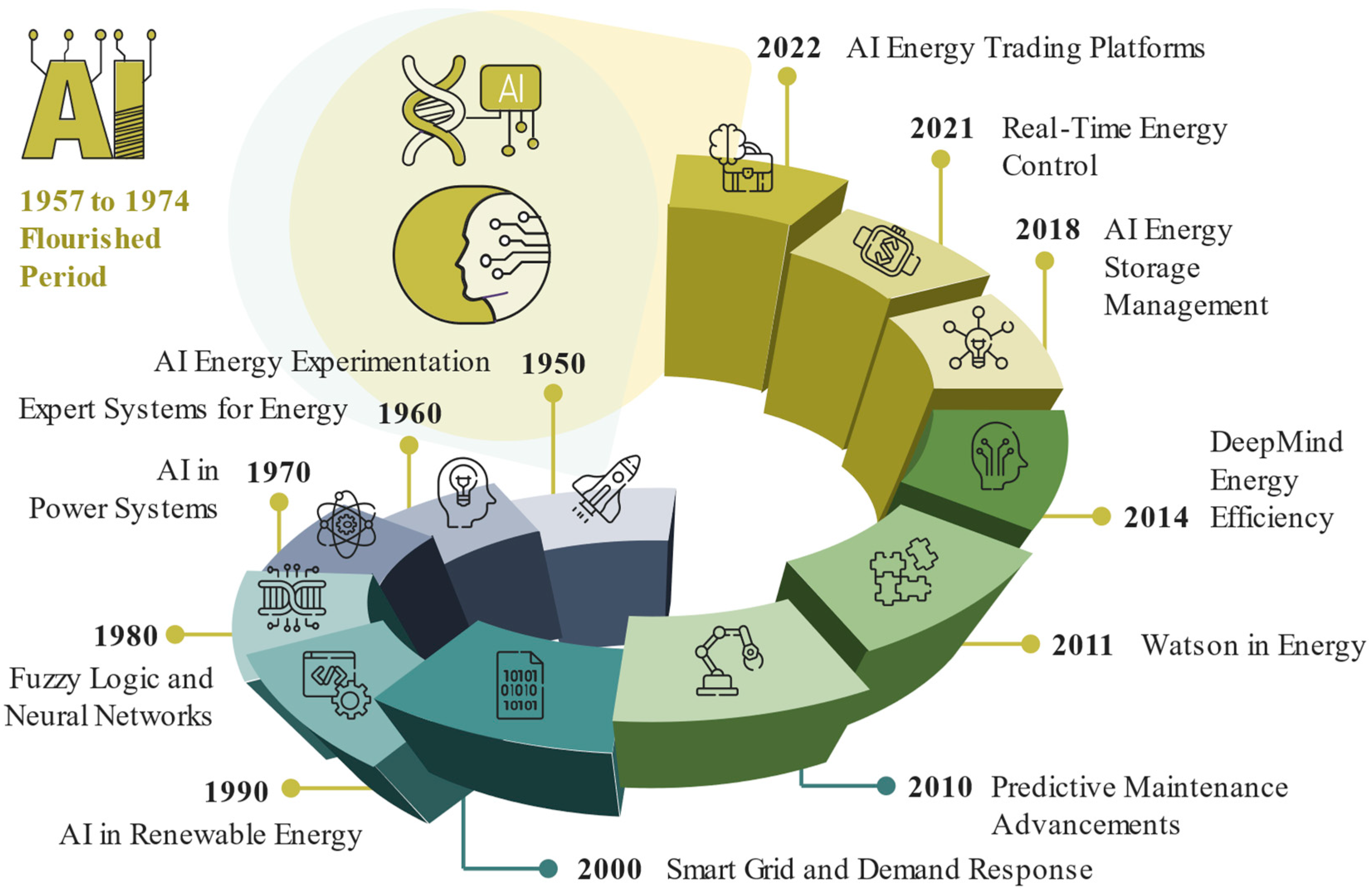
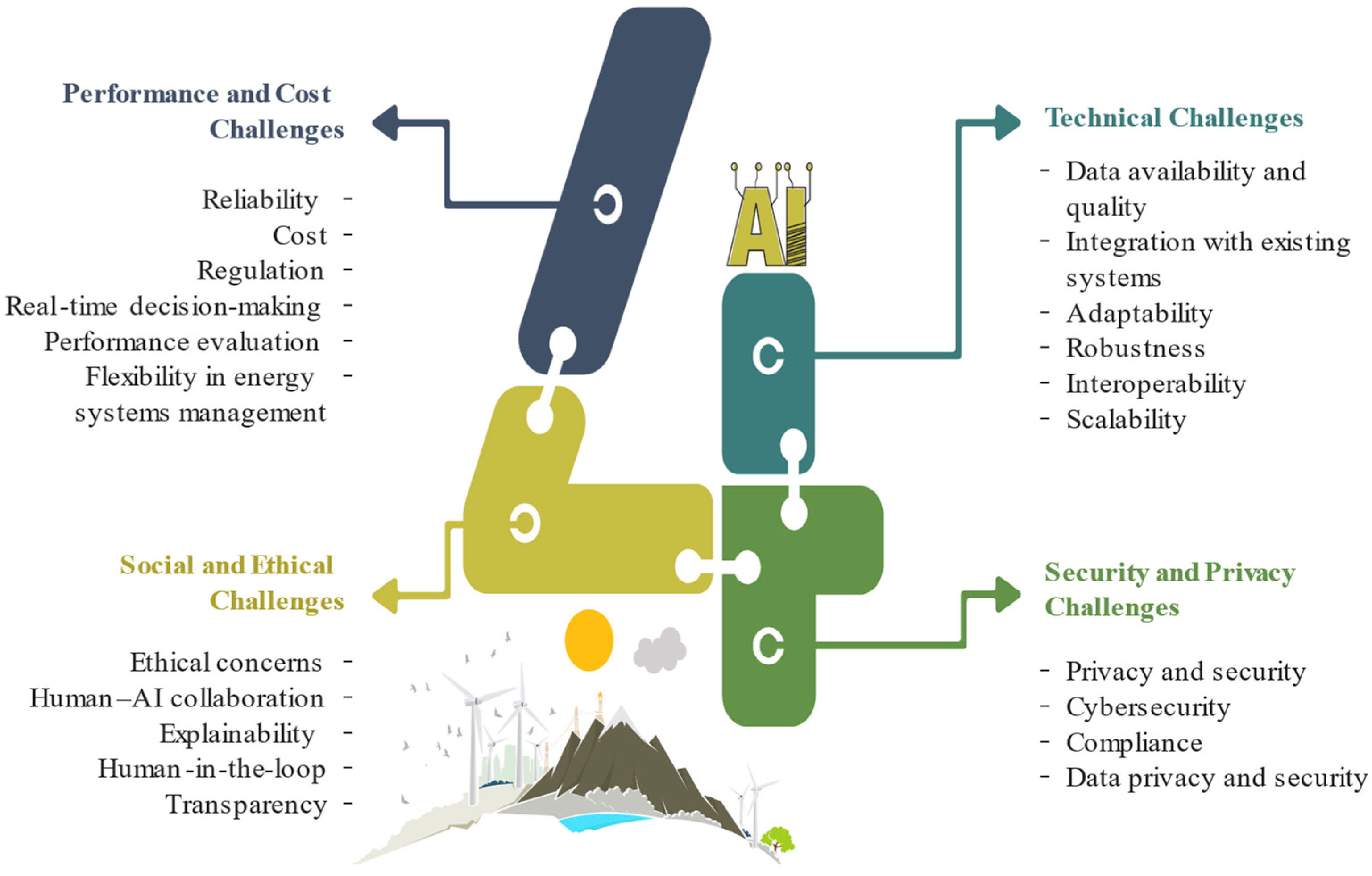
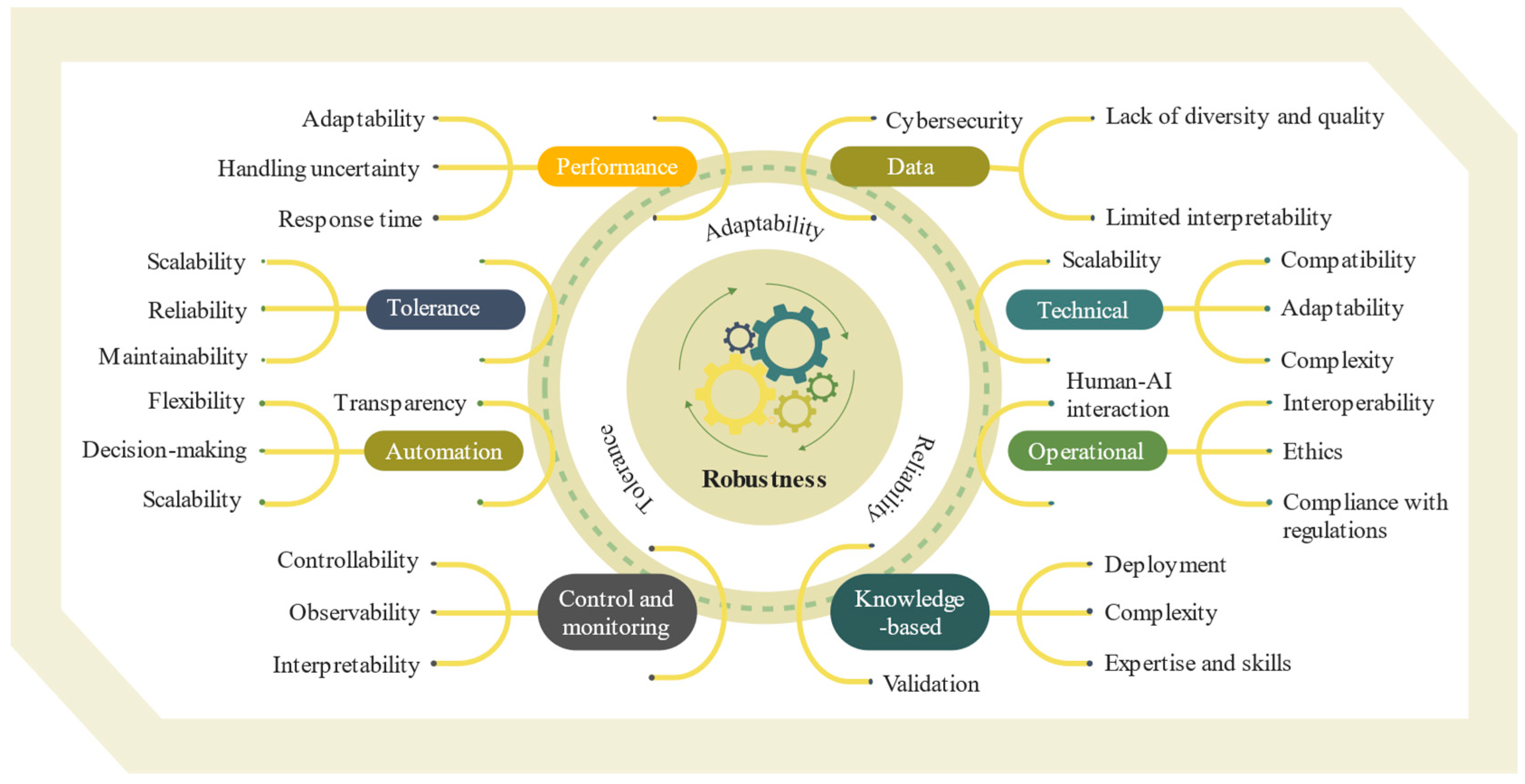
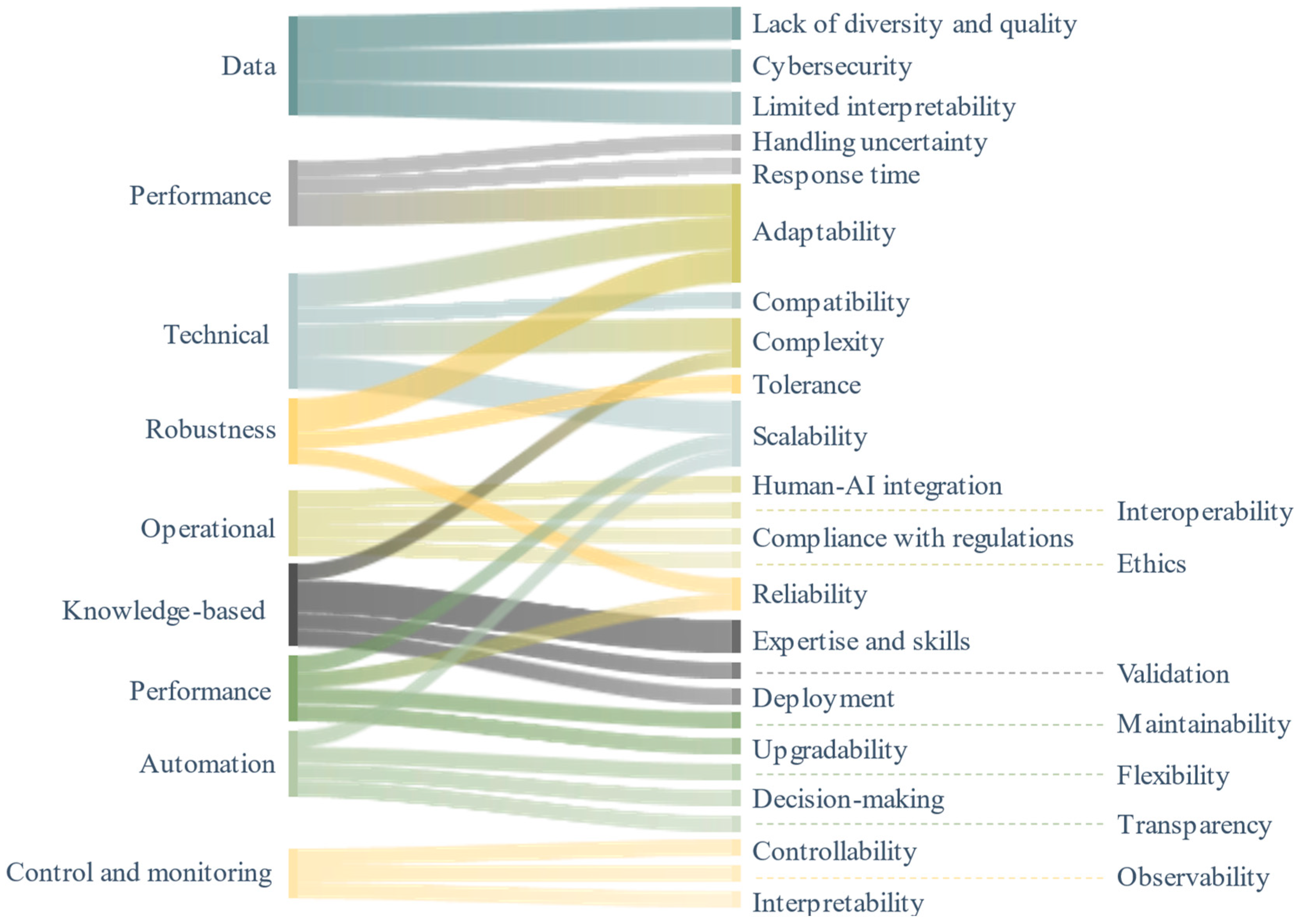

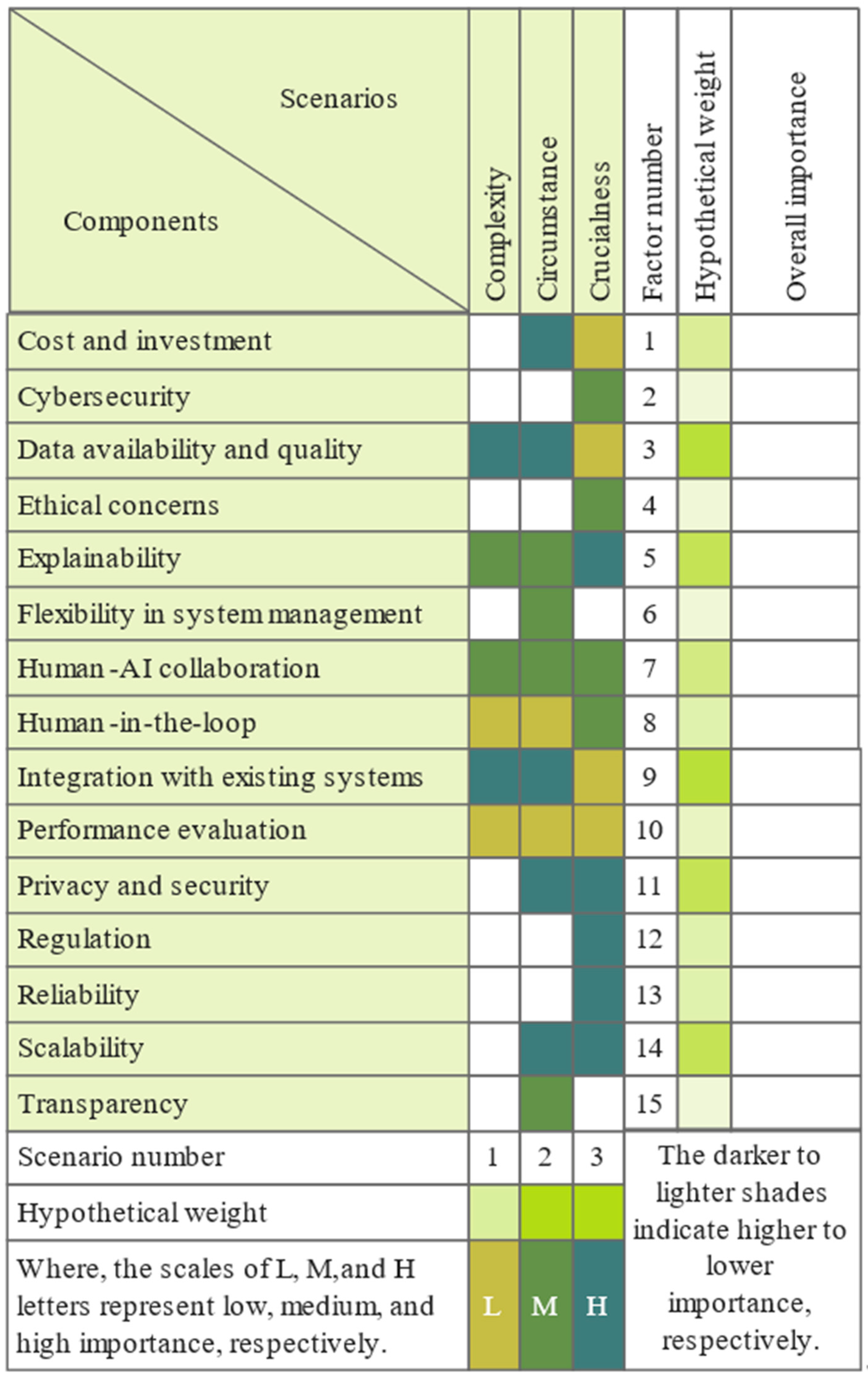
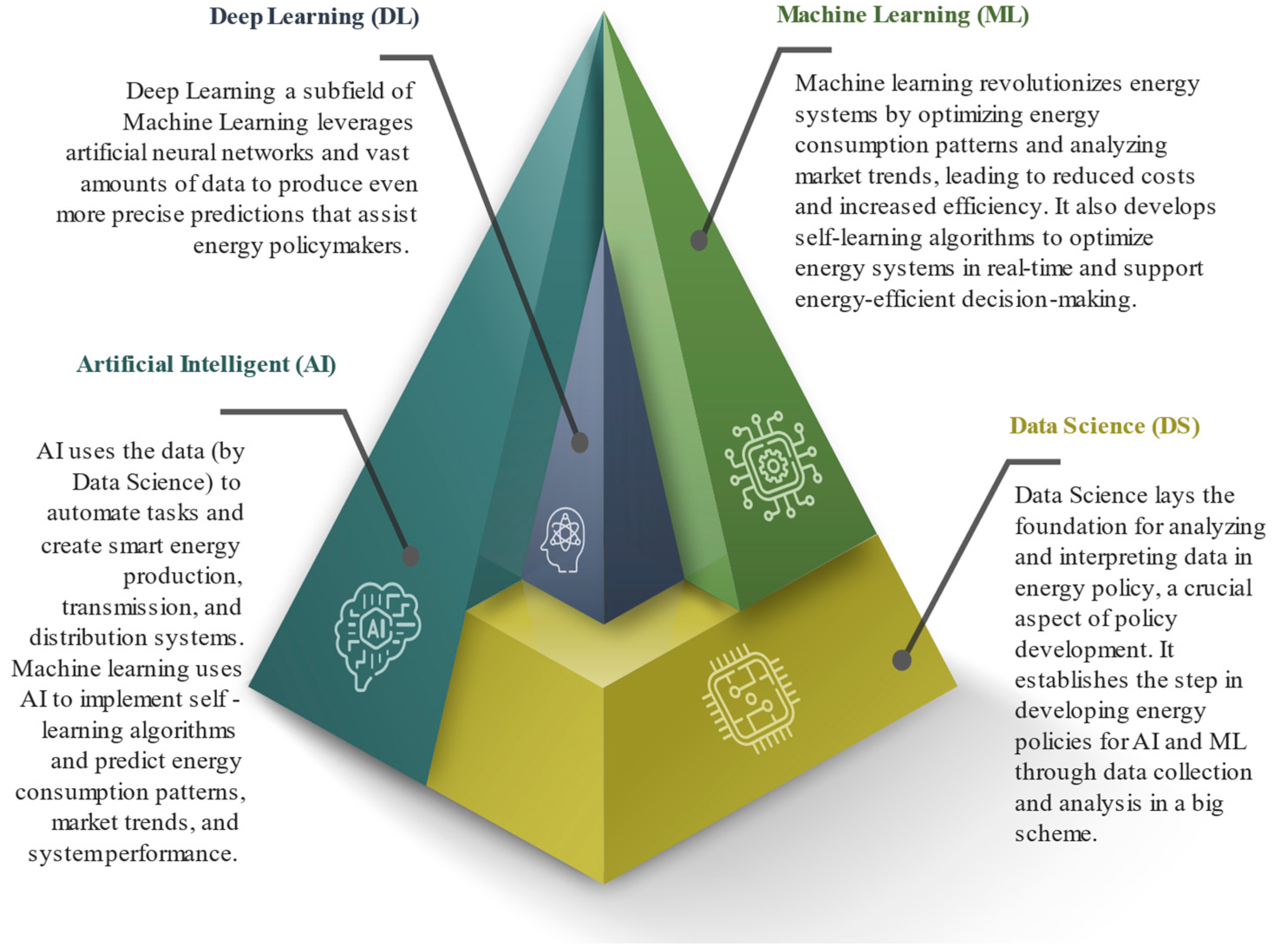
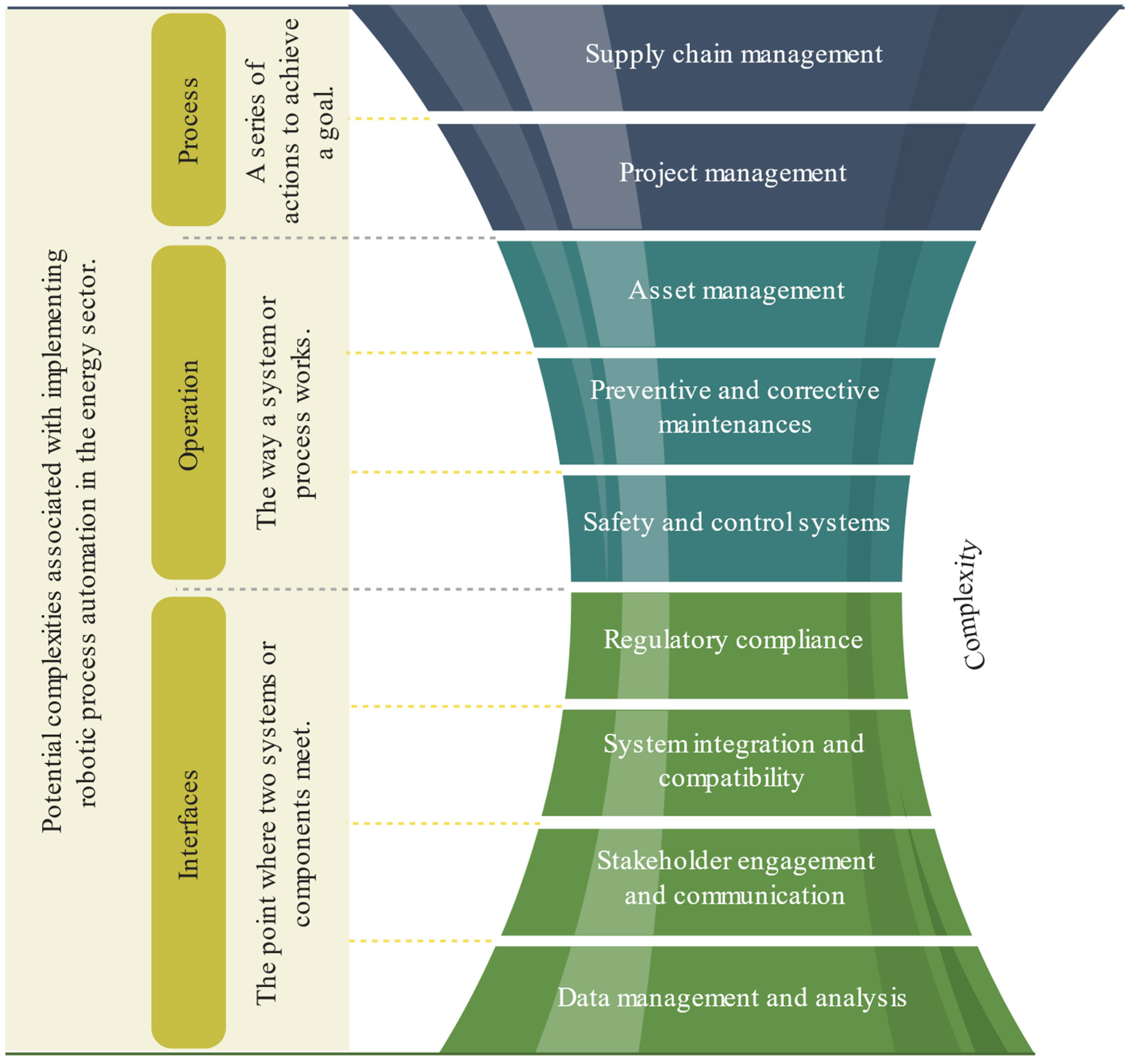
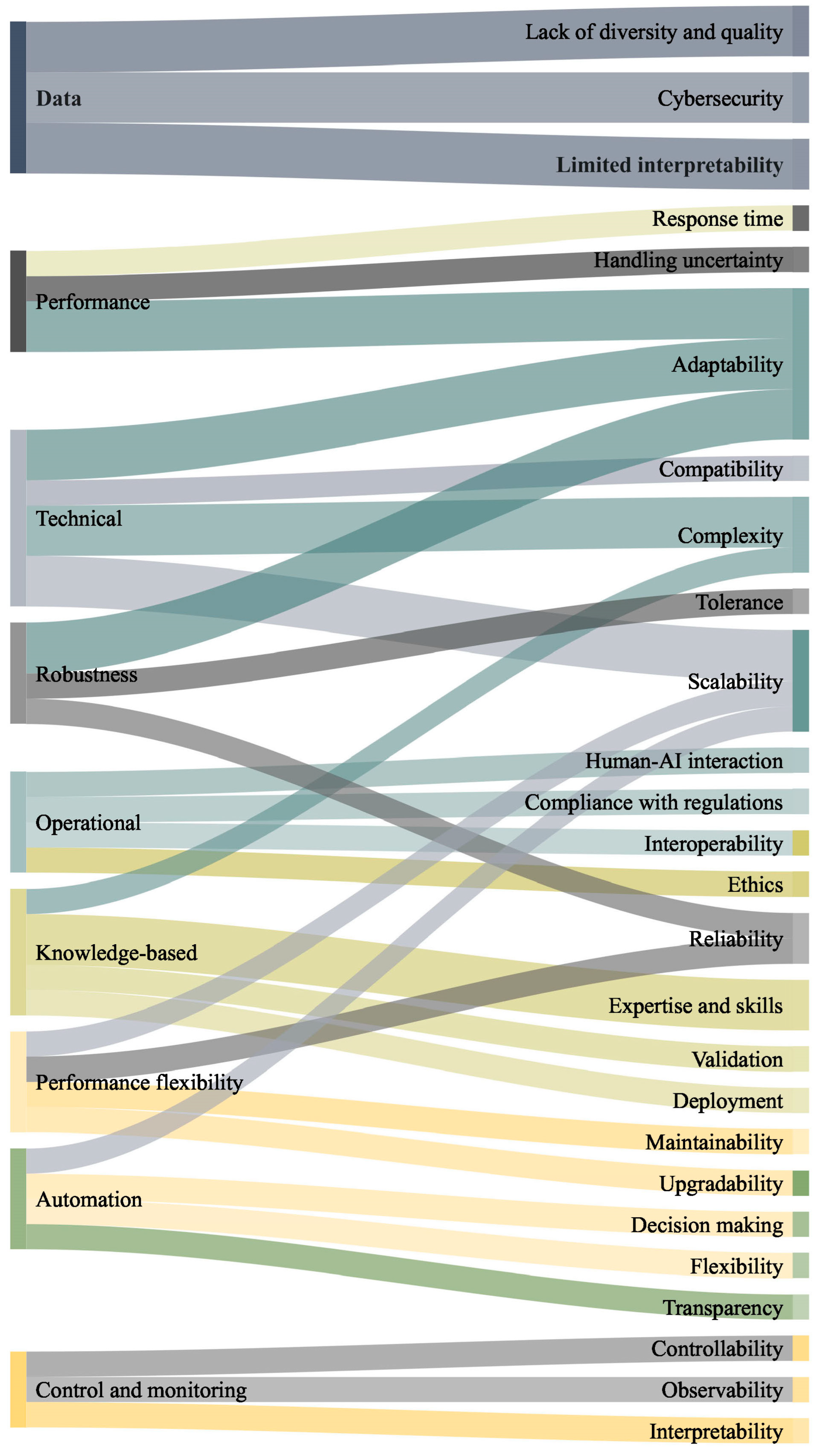

| No. | Challenge | Details |
|---|---|---|
| 1 | Data availability and quality | The availability and quality of data are critical factors for the successful implementation of AI-based systems in energy systems. These systems rely on large amounts of data for training and testing, and the data must be in a specific format and series. Inadequate or low-quality data can lead to poor results and inaccurate predictions, making it essential to have a robust data collection and preprocessing strategy in place. |
| 2 | Privacy and security | Using AI in energy systems raises concerns about protecting sensitive energy consumption and production information. This information can be collected and stored to identify patterns and make predictions, but it also creates a risk of data breaches and unauthorized access. Robust security measures such as encryption and secure data storage must be implemented to mitigate these risks. |
| 3 | Explainability | One of the challenges of AI systems is their lack of interpretability and understandability. This can make explaining their decision-making process to stakeholders challenging, particularly in critical decision-making tasks involving safety or compliance. To address this challenge, developing transparent AI systems that non-technical stakeholders can easily understand is essential. |
| 4 | Reliability | AI systems may not always produce reliable results, especially if they are not properly trained or if the data used to train them do not represent real-world conditions. To ensure the reliability of AI systems, it is essential to thoroughly test them and validate their results before deploying them in production. |
| 5 | Integration with existing systems | Integrating AI systems into existing energy systems can be a complex process that requires significant changes to existing infrastructure, such as hardware and software, as well as business processes and workflows. To ensure successful integration, it is essential to thoroughly understand the existing energy systems and plan for the integration of AI systems accordingly. |
| 6 | Cost | Developing and implementing AI systems can be expensive, which may not be feasible for some energy companies or organizations. It is essential to consider these systems’ costs and benefits carefully and prioritize investments in areas that will have the greatest impact. |
| 7 | Regulation | The lack of regulation and standards for the use of AI in energy systems can make it difficult for organizations to ensure compliance with the legal and ethical requirements. It is essential to stay informed about regulatory developments and work with regulators to establish the best practices for using AI in energy systems. |
| 8 | Scalability | AI systems may not be able to handle large-scale energy systems and the complexity and variability of real-world energy systems. To ensure that AI systems can scale to handle large-scale energy systems, developing AI systems that can scale and test them under realistic conditions is essential. |
| 9 | Human-in-the-loop | To ensure that AI systems complement and enhance human decision-making rather than replace it. Incorporating human oversight into the decision-making process or providing human operators with tools to verify and correct AI-generated decisions is essential. |
| 10 | Ethical concerns | Using AI in energy systems may raise ethical concerns, such as potential bias in decision-making and the displacement of human workers. It is essential to develop and implement ethical guidelines for using AI in energy systems and to ensure that the potential risks and impacts of AI systems are carefully considered. |
| 11 | Cybersecurity | Ensuring that AI systems are protected from cyber-attacks and unauthorized access is crucial for the security and integrity of energy systems. This can include implementing robust security measures, such as secure data storage and encryption, as well as regular security audits and vulnerability assessments. Additionally, it is vital to develop and implement incident response plans to address any potential security breaches or vulnerabilities. |
| 12 | Adaptability | As energy markets and regulations are constantly evolving, AI systems need to have the ability to adapt to these changes to remain effective and efficient. This may require regular updates and adjustments to the AI system and the development of methods for detecting and responding to changes in the energy market or regulatory environment. |
| 13 | Transparency | AI systems must be transparent in their decision-making processes. This can be achieved by providing clear explanations of the logic and reasoning behind a decision and making the system’s underlying data and algorithms available for review. This is also important for ensuring compliance with regulations and ethical guidelines. |
| 14 | Human–AI collaboration | For AI systems to be effective in energy systems, they must be able to work effectively with human operators and decision-makers. This may require the development of interfaces and tools that allow for accessible communication and collaboration between humans and AI systems. |
| 15 | Real-time decision making | Energy systems often require real-time decision-making, such as responding to energy demand or supply changes. AI systems must be able to make decisions quickly and accurately in real-time to be effective in these systems. |
| 16 | Performance evaluation | To ensure that AI systems perform well, evaluating their performance using appropriate metrics is essential. This may include metrics such as accuracy, efficiency, and scalability. |
| 17 | Scalability | As energy systems often have to handle large-scale operations, AI systems must also be able to scale to handle these operations. This may require the development of methods for distributed computing and parallel processing. |
| 18 | Robustness | Energy systems are often subject to uncertainty and variability, such as changes in weather or equipment failure. AI systems must handle these uncertainties and variabilities to be effective in these systems. |
| 19 | Interoperability | AI systems must be able to work with other systems and technologies, such as energy management systems or sensor networks. This requires the development of methods for integrating AI systems with other systems and technologies. |
| 20 | Data privacy and security | Ensuring that sensitive information and data generated by energy systems are protected from unauthorized access, use, or disclosure is a significant challenge in integrating AI into energy systems. This includes protecting data from cyberattacks and ensuring that data are used in a way that complies with regulations such as the General Data Protection Regulation (GDPR). |
| 21 | Compliance | Energy systems must comply with various regulations and standards, such as those related to safety and environmental protection. Integrating AI into energy systems can introduce new complexities and challenges in ensuring compliance with these regulations. |
| 22 | Human–AI collaboration | Ensuring that AI systems work seamlessly with human operators and decision-makers is a significant challenge in integrating AI into energy systems. This includes developing interfaces and workflows that allow human operators to understand and interact with AI systems easily and ensuring that AI systems consider human preferences and constraints when making decisions. |
| 23 | Explainability | One of the challenges in integrating AI into energy systems is the ability of humans to understand and explain how AI systems make decisions. This is important for building trust in AI systems as well as ensuring that AI systems are used in a way that is fair and transparent. |
| 24 | Human-in-the-loop | Ensuring that human operators and decision-makers can intervene in the decision-making process of AI systems is an important challenge in integrating AI into energy systems. This is necessary to ensure that AI systems are used in a safe, fair, and transparent way, and to allow human operators to take into account factors that the AI system may not capture. |
| 25 | Flexibility in energy systems management | Energy systems are complex and dynamic, and integrating AI into these systems can introduce new challenges in terms of flexibility and adaptability. This includes ensuring that AI systems can adapt to changing conditions and respond to unexpected events and that AI systems can work seamlessly with other systems and devices in the energy ecosystem. |
| Domain | The Main Contribution from a Macro Perspective |
|---|---|
| Data Science (DS) |
|
| Artificial Intelligence (AI) |
|
| Machine Learning (MS) |
|
Disclaimer/Publisher’s Note: The statements, opinions and data contained in all publications are solely those of the individual author(s) and contributor(s) and not of MDPI and/or the editor(s). MDPI and/or the editor(s) disclaim responsibility for any injury to people or property resulting from any ideas, methods, instructions or products referred to in the content. |
© 2023 by the author. Licensee MDPI, Basel, Switzerland. This article is an open access article distributed under the terms and conditions of the Creative Commons Attribution (CC BY) license (https://creativecommons.org/licenses/by/4.0/).
Share and Cite
Danish, M.S.S. AI in Energy: Overcoming Unforeseen Obstacles. AI 2023, 4, 406-425. https://doi.org/10.3390/ai4020022
Danish MSS. AI in Energy: Overcoming Unforeseen Obstacles. AI. 2023; 4(2):406-425. https://doi.org/10.3390/ai4020022
Chicago/Turabian StyleDanish, Mir Sayed Shah. 2023. "AI in Energy: Overcoming Unforeseen Obstacles" AI 4, no. 2: 406-425. https://doi.org/10.3390/ai4020022
APA StyleDanish, M. S. S. (2023). AI in Energy: Overcoming Unforeseen Obstacles. AI, 4(2), 406-425. https://doi.org/10.3390/ai4020022





